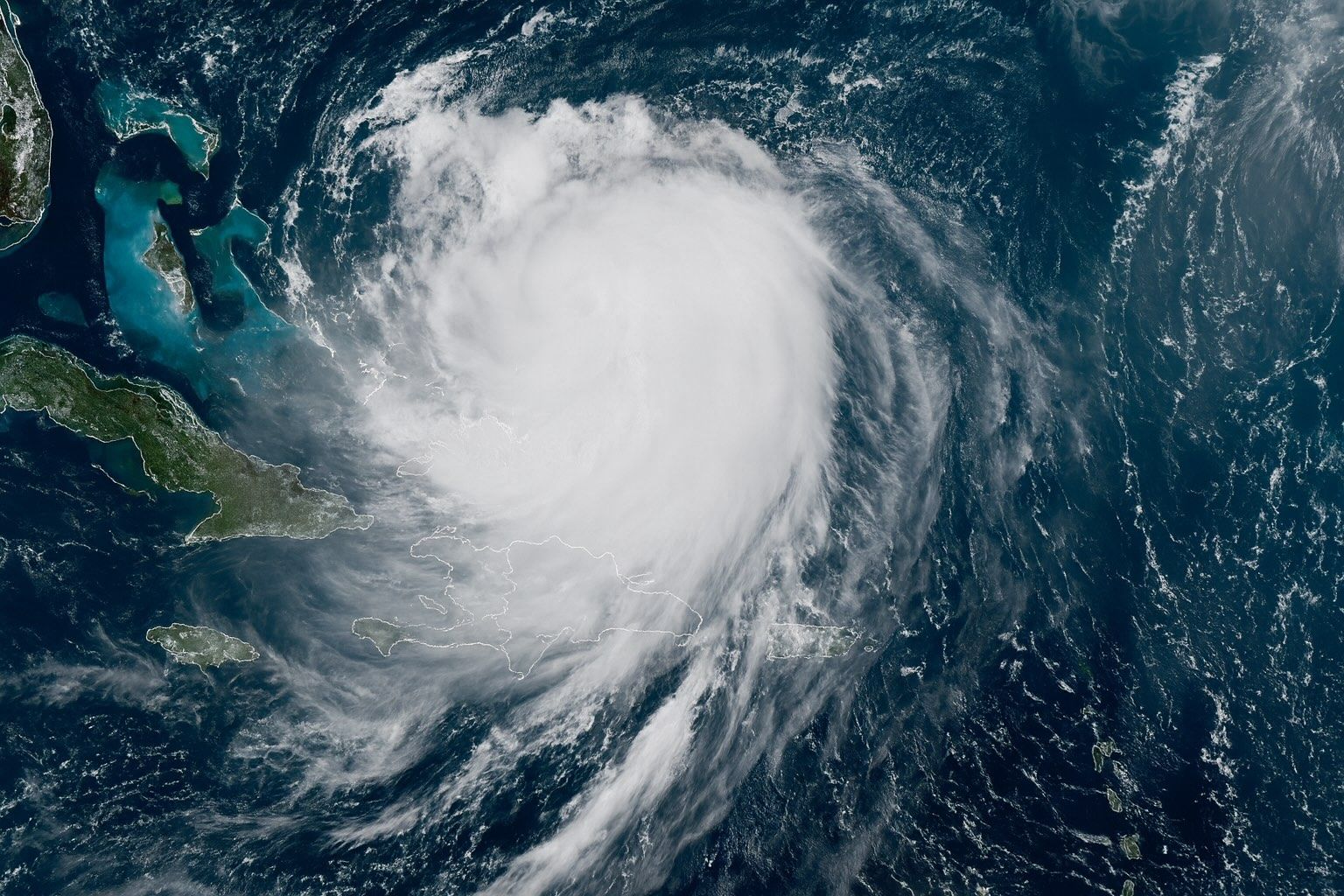- Erin is a Category 4 hurricane with sustained winds near 130 mph as of Aug. 18, 2025.
- The NHC placed Erin’s center near 24.1°N, 71.5°W, about 695 miles southwest of Bermuda.
- Hurricane-force winds extend about 80 miles from the center, and tropical-storm-force winds reach up to 230 miles.
- Forecast models indicate Erin will recur north between Bermuda and the U.S. East Coast, stay offshore, turn north on Tuesday, and accelerate northeast into the open Atlantic.
- Erin reached Category 5 on Aug. 16, 2025, with peak winds near 160 mph, in just over 27 hours from tropical-storm strength, making it the earliest Cat 5 hurricane observed in the open Atlantic.
- Erin is the fifth named storm of 2025 and the first to reach hurricane strength, with NOAA forecasting 13–18 named storms and 5–9 hurricanes for the season.
- The storm’s broad wind field is expected to cause life-threatening surf and rip currents along the U.S. East Coast, potentially reaching New Jersey and Long Island by mid-week.
- Dare and Hyde counties, North Carolina, declared a state of emergency and ordered evacuations of Hatteras and Ocracoke Islands, with Highway 12 potentially washed out by 15+ ft waves.
- Turks and Caicos Islands suspended public services on Providenciales and closed ports, while Bermuda prepared for outer bands with 20–25 ft seas and gusts over 40 mph as its disaster center activated.
- Puerto Rico experienced heavy rain and wind gusts up to 50 mph, with more than 147,000 power outages at the peak and restoration exceeding 96% by Monday.
Current Status and Live Tracking
Hurricane Erin is currently a powerful Category 4 storm spinning in the Atlantic – the first Atlantic hurricane of the 2025 season [1]. As of Monday evening (Aug. 18), the National Hurricane Center (NHC) placed Erin’s center near 24.1°N, 71.5°W, roughly 695 miles southwest of Bermuda [2]. The storm packs sustained winds of about 130 mph (210 km/h), solidly in Category 4 range (130–156 mph) and capable of catastrophic damage [3]. Erin is moving toward the northwest at ~10 mph, and forecasters expect a turn to the north on Tuesday [4].
Even more striking than its wind speed is Erin’s size – hurricane-force winds already extend 80 miles from the center, and tropical-storm-force winds reach out up to 230 miles [5]. This broad wind field means Erin’s effects span a huge area of ocean. The NHC continues to issue regular advisories and forecast maps for live tracking of Erin’s position and strength. (Interactive tracking maps and updates are available via NHC’s website and major weather outlets.) Residents and mariners in the storm’s vicinity should monitor these updates closely, as slight changes in Erin’s course or intensity could alter local impacts.
Forecast Path and Potential Impact Areas
Where is Erin headed? Forecast models are in strong agreement that Erin will recurve northward this week, steering roughly between Bermuda and the U.S. East Coast. The storm’s center is expected to stay offshore and not make landfall on the U.S. mainland [6]. According to the NHC, Erin’s core will pass east of the southeastern Bahamas on Monday, then begin turning north on Tuesday, moving between Bermuda and the U.S. East Coast by mid-week [7]. Later in the week, a mid-latitude trough is forecast to accelerate Erin northeastward into the open Atlantic, toward cooler waters. This track should keep the worst of the hurricane away from land. However, Erin’s expansive reach means coastal areas will still feel its effects despite the distant eye.
Bahamas and Caribbean: Over the weekend, Erin’s outer bands already swept past parts of the northern Caribbean. Heavy rainfall and gusty winds hit portions of Puerto Rico, the Virgin Islands, and Hispaniola on Sunday as Erin skirted north of the region [8] [9]. Puerto Rico saw flooding rains and tropical-storm-force gusts that knocked out power to more than 147,000 customers at one point (most were restored by Monday) [10]. In the Turks and Caicos Islands (TCI) and southeast Bahamas, authorities reported tropical-storm conditions on Monday as Erin passed nearby [11]. Bands of heavy rain were drenching those islands, raising the risk of flash flooding [12]. The Bahamas’ meteorology department warned all boats to stay in port, as “the seas could become extremely rough and dangerous” during Erin’s approach [13]. Local officials in the small island of Long Cay (southeastern Bahamas) urged residents to move to the main island and finalize storm preparations ahead of Erin [14]. Thankfully, Erin’s center remained far enough offshore to spare the Caribbean any direct hurricane strike, but the fringe impacts were still significant.
United States East Coast: Forecasters warn that even without a U.S. landfall, Hurricane Erin will likely impact a long stretch of the East Coast through hazardous surf, currents, and possibly fringe winds. The enormous wind-field is generating a “giant plunger” effect on the ocean’s surface, according to meteorologist Alex Sosnowski – expect large swells propagating outward from the storm [15]. The NHC cautions that life-threatening surf and rip currents will affect beaches from the Bahamas and Florida up the entire U.S. East Coast, Bermuda, and even Atlantic Canada over the next several days [16]. In fact, beachgoers as far north as New Jersey and Long Island are likely to see dangerous rip currents and rough surf by mid-week, even though Erin stays hundreds of miles offshore. “These rough ocean conditions will likely cause life-threatening surf and rip currents,” the NHC warned, advising people to follow local beach safety alerts [17]. Coastal flooding is another concern – low-lying shore areas could see tidal inundation at times of high tide. For example, the National Weather Service in Delaware issued advisories for minor flooding in bayside communities, with 8–12 ft seas and high rip current risk along Delaware’s coast by mid-week [18].
The greatest U.S. impacts are expected in North Carolina’s Outer Banks, which protrude into the Atlantic. Even though Erin’s eye should stay well offshore, its outer circulation may brush the Outer Banks with tropical-storm-force winds and storm surge. The NHC says there is a possibility of tropical-storm conditions and coastal flooding in the Outer Banks beginning late Wednesday [19]. In fact, Tropical Storm Watches and Storm Surge Watches have already been issued for much of the Outer Banks (from Beaufort Inlet to Duck, NC, including Pamlico Sound) [20]. Waves topping 15–20 feet are forecast to batter the NC coast Wednesday into Thursday [21]. Low-lying sections of Highway 12 (the lone road linking the Outer Banks) could be washed out or inundated by sand and water, potentially cutting off communities [22] [23]. Given these threats, local authorities in North Carolina have ordered evacuations: on Monday, Dare and Hyde counties declared states of emergency and told all tourists and residents to evacuate Hatteras Island and Ocracoke Island (the two fragile barrier islands most exposed to Erin) [24]. Long lines of cars and ferry traffic formed as people heeded the mandatory orders to leave [25]. Officials warned that anyone who stays behind “should not count on getting any help” during the storm, since emergency crews may be unable to reach the islands once conditions deteriorate [26].
Bermuda: The island of Bermuda, located east of the Carolinas, is warily watching Erin’s progress. Current forecasts have Erin passing to Bermuda’s west, potentially keeping the strongest winds away from the island. Even so, Bermuda is likely to see deteriorating conditions by Thursday, with outer bands bringing gusty winds and large swells. The NHC advises Bermuda to monitor Erin, as strong winds could reach the island by Thursday if the storm’s track shifts closer [27]. Bermuda’s Weather Service predicts wave heights of 20–25 feet in surrounding waters at Erin’s nearest approach Thursday night [28]. Government officials in Bermuda have already issued stern warnings to the public: “Surfers, swimmers and boaters must resist the temptation to go out. The waters will be very dangerous and lives will be placed at risk,” urged Jache Adams, Bermuda’s acting Minister of National Security [29]. In short, Bermuda could face tropical storm conditions and treacherous seas even without a direct hit. By Friday, Erin is expected to accelerate past Bermuda toward the north Atlantic, weakening as it moves over cooler waters. Atlantic Canada (Nova Scotia, Newfoundland) might then experience high surf and rip currents heading into the weekend as the fading cyclone passes well offshore [30].
Expert Insights and Climate Context
Meteorologists and climate scientists have been closely analyzing Hurricane Erin’s behavior, as the storm has exhibited some remarkable characteristics. One striking aspect was Erin’s explosive intensification over the weekend. In barely more than a day, Erin rocketed from a minimal tropical storm to a Category 5 hurricane. “Erin’s already large size and intensity are acting like a giant plunger on the sea surface,” noted AccuWeather senior meteorologist Alex Sosnowski, referring to how the storm’s force was heaping up the ocean and generating massive swells [31]. Sosnowski also highlighted Erin’s rapid intensification record – the cyclone morphed from a tropical storm to a Cat 5 (the top of the Saffir-Simpson scale) in just over 27 hours, making it “among the fastest-strengthening storms on record” in the Atlantic [32]. Indeed, Erin’s peak wind speed jumped from about 60 mph to 160 mph between Friday and Saturday. According to Yale Climate Connections, Erin became the earliest Category 5 hurricane ever observed in the open Atlantic (reaching Cat 5 on Aug. 16) and one of the fastest to strengthen so dramatically [33] [34]. Such rapid leaps in intensity are usually rare, but have occurred with a few notorious storms in recent decades (e.g. hurricanes Wilma, Felix, and last year’s Hurricane Milton) [35].
Scientists point out that exceptionally warm ocean waters helped fuel Erin’s explosive growth. In mid-August, sea surface temperatures along Erin’s path were unusually high – well above the 26.5 °C (80 °F) threshold needed for hurricane development [36]. “Erin’s … circulation took advantage of … unusually warm sea surface temperature for mid-August,” meteorologist Bob Henson noted, which provided ample energy for the storm to tap into [37]. Light upper-level wind shear and Erin’s compact core structure also contributed to its steep intensification curve [38]. Climate experts warn that these kinds of rapid intensification events are becoming more common as ocean temperatures rise. “Scientists have linked the rapid intensification of hurricanes in the Atlantic to climate change, which is driven by human-caused greenhouse gas emissions,” the Associated Press reported in coverage of Erin [39]. A warmer atmosphere and ocean can increase the odds of storms rapidly gaining strength, sometimes outpacing forecasts and giving coastal communities less time to prepare. Erin’s burst to Category 5 – followed by some weakening due to an eyewall replacement cycle – underscores how volatile hurricane intensity can be when conditions are ripe.
Despite some fluctuations, Erin remains a formidable cyclone. “You’re dealing with a major hurricane… It’s a dangerous hurricane in any event,” emphasized Richard Pasch, a senior NHC forecaster [40]. Even as Erin wobbled between Categories 3 and 4, Pasch stressed that the focus should be on the hazards: “The intensity is fluctuating. It’s a dangerous hurricane in any event.” [41] Meteorologists expect Erin to remain a “major” hurricane (Category 3 or higher) through midweek [42] [43], given that it will stay over warm waters for the next couple of days. By late week, increasing wind shear and cooler waters should induce a more steady weakening trend. Still, NHC forecasters note that Erin’s wind field is expanding as it moves north, which means the area experiencing strong winds and seas is growing [44]. In fact, the NHC cautioned that their standard probabilistic wind forecasts might be underestimating the risk at farther distances, because Erin’s gale envelope is larger than average for a storm of its strength [45] [46].
From a seasonal perspective, Hurricane Erin fits into what is projected to be an active Atlantic hurricane season. NOAA had forecast an “above-normal” season in 2025 with 13–18 named storms, of which 5–9 could become hurricanes and 2–5 could reach major hurricane status [47]. Erin is already the fifth named storm of 2025 (name “E” in the list) and the first to reach hurricane strength [48]. Remarkably, by attaining Category 5, Erin made 2025 the fourth Atlantic season in a row to produce at least one Category 5 hurricane [49]. (The last few years saw hurricanes like 2022’s Ian and 2024’s Milton hit Cat 5.) Climatologically, mid-August through late September is the peak of hurricane activity in the Atlantic [50], so it’s not unusual for a potent storm like Erin to form now. However, the string of intense hurricanes in recent years has experts and coastal residents on high alert. “Fast-changing storms like this can catch people off guard,” said one meteorologist, noting the importance of real-time monitoring. Mike Brennan, the NHC’s director, also underscored the need for vigilance with Erin. The hurricane’s impacts (especially rough surf) will be widespread and long-lasting this week, he warned, adding: “It’s just not going to be a very safe environment to be in the ocean.” [51]
Public Safety Information and Preparedness Advice
As Hurricane Erin churns offshore, officials at all levels are urging the public to stay safe and be prepared. Even if the storm isn’t making landfall, its indirect impacts can be dangerous. Here are key safety tips and preparedness measures to keep in mind:
- Follow Evacuation Orders: If local authorities order an evacuation in your area, do not delay – evacuate promptly as instructed. Coastal counties in North Carolina have made clear that in mandatory evacuation zones, anyone who remains is on their own and emergency services may not be able to respond during the storm [52]. It’s simply not worth risking your life by trying to ride out a major hurricane on a vulnerable barrier island or flood-prone zone. Have an evacuation route planned (know the nearest storm shelter or higher ground) and leave early to avoid being trapped by flooded roads.
- Prepare an Emergency “Go Bag”: Now is the time to ensure you have an emergency supply kit ready. Meteorologists advise coastal residents to use Erin as a cue – pack your hurricane go-bag with essentials in case you need to evacuate quickly [53]. This kit should include important documents, medications, basic first aid supplies, flashlights, batteries, cash, and several days’ worth of non-perishable food and water for your family and pets. Don’t forget items like phone chargers, a battery-powered radio, and personal hygiene items. Having these supplies on hand will keep you self-sufficient if you lose power or need to relocate.
- Secure Your Home and Property: Take steps to minimize damage to your property before severe weather arrives. Bring outdoor furniture, grills, and loose objects inside or tie them down – these can become dangerous projectiles in high winds. If you live in a coastal or low-lying area, consider placing sandbags to divert minor flooding and moving valuable items to higher floors. Board up or shutter windows if strong winds are forecast, to protect against flying debris. Make sure gutters and storm drains are clear so rain can properly drain away. These actions can make a big difference in reducing damage.
- Stay Out of the Water: Perhaps the most pervasive danger from Erin will be in the surf. Do NOT swim, surf, or boat in areas under high surf or rip current advisories. Even experienced swimmers and surfers can be quickly overwhelmed by the powerful swells and currents generated by a distant hurricane. “It’s just not going to be a very safe environment to be in the ocean,” NHC Director Mike Brennan warned, referring to the rough seas Erin is stirring up along the East Coast [54]. Red flags are flying at many beaches from Florida to New England, signaling extreme rip current risk. Heed those warnings and stay on shore until officials declare the waters safe. Life-threatening rip currents can pull even strong swimmers out to sea. If you’re a boater, check marine forecasts – small-craft advisories are likely in effect, and sensible mariners will avoid heading out until the storm swells subside. It’s best to secure your vessel in port or haul it out if possible.
- Stay Informed and Don’t Underestimate the Storm: Information is a crucial resource in a hurricane. Keep up-to-date with trusted sources like the NHC, National Weather Service, and local emergency management for the latest on Erin’s track and local advisories [55]. Sign up for community emergency alerts (text or email notifications) if available. Use a battery-powered radio or smartphone (with backup power) to receive news if electricity goes out. Above all, never underestimate a hurricane’s potential impact – even if it’s not coming ashore near you [56]. Erin’s impacts (flooding, surf, winds) can extend far from its center. As the saying goes, “Hide from the wind, run from the water.” That means shelter in a sturdy place away from windows during high winds, but evacuate if you’re in an area threatened by storm surge or flooding. By respecting the power of the storm and following official guidance, you greatly increase your safety.
Recent News and Emergency Responses
Emergency actions and storm response efforts are underway in multiple regions as Hurricane Erin advances. Here’s a roundup of the latest developments and how different areas are coping:
- Outer Banks, North Carolina: Local authorities have taken aggressive measures to prepare for Erin’s approach. On Monday, Dare County (which encompasses much of the Outer Banks) declared a state of emergency and, along with neighboring Hyde County, ordered mandatory evacuations of Hatteras and Ocracoke Islands [57]. These barrier islands, popular with tourists, are extremely susceptible to coastal flooding. Long lines of vehicles were seen at ferry terminals as visitors and residents heeded the evacuation orders and left the islands [58]. The evacuations come at the height of the summer tourist season, so thousands of vacationers had to cut trips short. “We definitely thought twice… but they said ‘mandatory’ and that pretty much means ‘get out of here,’” one evacuee told reporters [59]. The National Park Service closed campgrounds and facilities in the Cape Hatteras National Seashore ahead of the storm. North Carolina’s Department of Transportation positioned crews and equipment, expecting that Highway 12 – the only road linking these islands – could be overwashed or damaged by 15+ ft waves and surge [60] [61]. Residents who chose to stay were warned they might be isolated for days. This is Ocracoke’s first full evacuation since Hurricane Dorian in 2019, and many locals, while concerned, are hopeful Erin will stay far enough offshore to spare them worst-case damage [62] [63].
- Elsewhere in the U.S. East Coast: Government agencies up and down the East Coast are on alert for indirect impacts. Beach towns from Florida to New England have posted warnings about rip currents and high surf due to Erin. In Florida, no significant impacts are expected on land, but the state’s eastern beaches are flying double-red flags in some areas (indicating water closed to public) as a precaution. Further north, parts of Georgia and the Carolinas are anticipating higher-than-normal tides and minor beach erosion. The Mid-Atlantic states are also bracing: for instance, the U.S. Navy in Virginia moved a few vessels to sea as a standard precaution to avoid damage in port from potential swell and surge. In Delaware and New Jersey, officials warned that even a distant hurricane can produce deadly rip currents – lifeguards will be on high alert and may restrict swimming on certain days. The New Jersey shore and Long Island, NY, are expecting rough surf by mid-week; New York’s emergency management urged surfers to “think twice” and families to keep a close eye on children at the beach. So far, no major evacuations have been needed outside of North Carolina, but coastal flood watches have been issued for vulnerable spots like the Outer Banks (NC) and parts of coastal Virginia and Maryland as a belt of onshore winds on Erin’s periphery could push water into sounds and back bays. Local governments are positioning rescue crews and high-water vehicles inland in case of any flooding in typically flood-prone neighborhoods.
- Turks and Caicos & The Bahamas: Erin’s closest brush with land was with the Turks and Caicos and Bahamas on Monday. In the Turks and Caicos Islands, an overseas British territory, officials took no chances – they suspended all public services on the main island of Providenciales and ordered residents in low-lying areas to stay home and be ready to evacuate if conditions worsened [64]. Ports and airports were temporarily closed. The TCI Regiment (a local defense force) had troops on standby for post-storm relief if needed [65] [66]. Fortunately, Erin’s center stayed just far enough north that TCI avoided a direct hit, though it experienced tropical storm winds, heavy rain, and pounding surf that caused some coastal erosion. In the southeastern Bahamas, numerous small islands endured tropical-storm conditions as Erin passed. The Bahamian government had issued a Tropical Storm Warning for its southeast islands and a Watch for the central Bahamas [67]. Residents of islands like Mayaguana, Inagua, and Long Cay were advised to complete preparations and shelter in place by Sunday night. On Long Cay (population only a few dozen), the local administrator urged everyone to relocate to the larger island of Acklins as a safety measure [68]. Thankfully, there were no immediate reports of serious damage in the Bahamas as Erin’s worst winds remained offshore. Power outages were limited, but the surging seas did cause minor flooding in some settlements. The Bahamas’ Prime Minister spoke on local radio Monday, reassuring citizens that the nation’s disaster management agency was ready to assist any hard-hit communities and reminding boaters to stay docked until seas subside.
- Puerto Rico and U.S. Virgin Islands: Though Erin did not hit Puerto Rico directly, the storm’s outer rainbands brought a soggy Sunday to the island. Some of Erin’s thunderstorms trained over eastern Puerto Rico, dropping torrential rain that flooded roads and low areas. Wind gusts topping 50 mph in squalls knocked down tree limbs and power lines. At the peak of the bad weather, more than 147,000 customers lost electricity in Puerto Rico (mostly in the northeast part of the island) [69]. Crews from Luma Energy, the grid operator, worked through Sunday night, and by early Monday power was restored to over 96% of those affected [70]. Meanwhile, over 20 flights to/from Puerto Rico and the nearby U.S. Virgin Islands were canceled due to the storm’s high winds [71]. The U.S. Coast Guard had closed ports in San Juan and other areas as a precaution, but by Monday morning, with conditions improving, all ports in PR and the USVI re-opened for normal operations [72]. Local officials reported some landslides and minor flood damage in rural areas, but overall Erin’s glancing blow caused minimal lasting damage in Puerto Rico. The experience served as a reminder, however, that even a far-off hurricane can disrupt island infrastructure. Emergency management offices in San Juan took the opportunity to test communication systems and refine their coordination with the NHC – a useful drill early in the season.
- Bermuda: Though Erin is still days away from Bermuda, the island is already ramping up preparations. The Bermuda Weather Service has issued preliminary statements about a “potential threat” from Hurricane Erin later this week. While the forecast suggests the core will pass at a safe distance, Bermuda expects to feel at least tropical storm conditions (gusts over 40 mph, rain squalls) by Thursday. In response, Bermuda’s National Disaster Coordination Centre activated on Monday to begin readiness plans. The island’s harbors will see boats securing at moorings or being hauled out of the water in the coming days. Bermuda’s government has alerted the public to expect dangerous surf on south shore beaches by Wednesday, even before any wind arrives. As noted earlier, officials have strongly warned citizens to avoid the ocean – surfing or swimming in storm swells is not worth the risk [73]. Many Bermudians have decades of hurricane experience; they’re using the next day or two to stock up on groceries, test generators, and trim trees. By Wednesday, schools and businesses will likely announce early closures if the forecast warrants. Notably, Bermuda regularly weathers strong hurricanes with well-enforced building codes and preparedness, so confidence is high despite Erin’s intimidating strength. Still, as one Bermuda weather director put it, “We’ll breathe easier once Erin turns away – until then, we prepare for the worst and hope for the best.”
In summary, Hurricane Erin has prompted a broad swath of preventative measures and news coverage – from evacuation orders on North Carolina’s coast, to precautionary shutdowns in Caribbean islands, to advisories for boaters and beachgoers hundreds of miles away. Thus far, Erin has not caused catastrophic damage on land, and officials aim to keep it that way through proactive evacuations and public warnings. The coming days will reveal the full extent of Erin’s impacts as it makes its closest approaches to the Outer Banks and Bermuda. Emergency responders and relief agencies (like the Red Cross and Convoy of Hope) are on standby in case Erin’s fringe effects cause any communities to need assistance. Overall, this event is underscoring the importance of preparedness and respect for nature’s power – a theme echoed in many news reports as the storm continues to dominate headlines.
Historical Context: Past Storms Named “Erin”
The name Erin may sound familiar to weather-watchers – and for good reason. “Erin” has been used for seven tropical cyclones in the Atlantic since 1989 [74]. Unlike names such as Katrina or Andrew, the name Erin has never been retired, meaning none of the previous Erin storms caused damage so extreme that the World Meteorological Organization removed the name from rotation [75]. However, a few past Erins have been noteworthy in their own right:
- Hurricane Erin (1995): The 1995 incarnation of Erin was the most impactful to date. This storm struck Florida twice – first crossing the central East Coast of Florida (near Vero Beach) as a Category 1, and then, after restrengthening over the Gulf, hitting the Florida Panhandle (near Pensacola) as a Category 2 [76]. Erin 1995 was actually the first hurricane to hit the U.S. mainland since Hurricane Andrew in 1992 [77], and it served as a wake-up call in what turned out to be a very busy 1995 season. The storm caused significant wind and flood damage in Florida, resulting in 6 direct fatalities and around $700 million in damage [78]. Luckily, it was overshadowed by later hurricanes in 1995 (like Opal), but Erin was a reminder that even a mid-strength hurricane can be destructive.
- Hurricane Erin (2001): In early September 2001, another Hurricane Erin roamed the Atlantic. Interestingly, Erin 2001 formed near Cabo Verde off Africa – much like 2025’s Erin – and it was being tracked in the Atlantic on the morning of September 11, 2001 [79]. (Because of the tragic events of 9/11, that Erin received little media attention at the time.) This 2001 storm became a long-lived Cape Verde hurricane that reached Category 3 strength at its peak [80]. Fortunately, it never made landfall; Erin 2001 passed well east of the U.S. coast and also east of Bermuda before curving out to sea. It was notable for its longevity (spanning over two weeks) and for staying out over open water.
- Tropical Storm Erin (2007): Not all “Erins” have been powerful hurricanes. In August 2007, Tropical Storm Erin formed in the Gulf of Mexico and made landfall in Texas as a weak, rain-heavy storm. What made TS Erin 2007 unusual is what happened after landfall – the system’s remnants moved inland and then unexpectedly regenerated over Oklahoma, producing an eye-like feature and near-tropical-storm winds even though it was well over land [81] [82]. This rare “inland tropical storm” caused flooding in Oklahoma and sparked discussion among meteorologists about how such inland reorganization can occur. It showed that even a weak storm named Erin could do something very unexpected.
- Other Erins (1989, 2013, 2019): The first-ever cyclone named Erin in the Atlantic appeared in 1989, though it remained relatively modest (reaching Category 2 strength but staying at sea) [83]. Subsequent uses of the name include Tropical Storm Erin (2013), which stayed out in the eastern Atlantic, and Tropical Storm Erin (2019), which formed near the U.S. East Coast. TS Erin 2019 never became a hurricane; it dissipated after bringing some heavy rain to Atlantic Canada as a post-tropical system. Each of these was a footnote in their respective seasons.
In total, the name Erin has been associated with a wide variety of storm behaviors – from landfalling U.S. hurricanes to oddball inland storms. Because none caused truly catastrophic devastation, the name lives on in the rotating list. It’s worth noting that hurricane names are reused every six years unless retired [84]. So far, “Erin” hasn’t been retired, underscoring that while past Erins had impacts, they weren’t cataclysmic. However, as history shows, every storm named Erin has its own personality and challenges. The legacy of Erin 1995 taught Floridians not to be complacent after a quiet spell. Erin 2007 taught meteorologists that tropical remnants can still surprise us. And now Erin 2025 is writing its own chapter – becoming the strongest “Erin” on record (Category 5 at peak) and testing preparedness along the Atlantic seaboard.
This historical context also highlights an important point: the name may be the same, but no two storms are alike. Whether it’s Erin or any other name, communities must evaluate the threat based on the storm’s actual characteristics, not past experiences alone. The fact that Erin 2025 rapidly exploded into a monster storm has little to do with Erin 1995 except coincidence. As such, emergency managers always emphasize preparing for this storm, not the last one. With that in mind, those in Erin’s potential path or wave influence should continue to stay vigilant until the storm has safely passed.
Sources: National Hurricane Center (NOAA) advisories and discussions [85] [86] [87] [88]; CBS News [89] [90]; Reuters [91] [92] [93] [94]; Associated Press via The Guardian [95] [96] and ABC News [97] [98]; Yale Climate Connections [99] [100]; Convoy of Hope Disaster Services [101] [102]; Tidal Basin Group emergency management insights [103] [104].
References
1. www.reuters.com, 2. www.nhc.noaa.gov, 3. www.cbsnews.com, 4. www.nhc.noaa.gov, 5. weather.com, 6. www.cbsnews.com, 7. www.cbsnews.com, 8. www.theguardian.com, 9. www.theguardian.com, 10. www.theguardian.com, 11. www.nhc.noaa.gov, 12. www.nhc.noaa.gov, 13. www.reuters.com, 14. www.reuters.com, 15. www.reuters.com, 16. www.nhc.noaa.gov, 17. www.cbsnews.com, 18. weather.com, 19. www.nhc.noaa.gov, 20. www.reuters.com, 21. www.reuters.com, 22. 6abc.com, 23. 6abc.com, 24. www.reuters.com, 25. 6abc.com, 26. www.reuters.com, 27. www.nhc.noaa.gov, 28. 6abc.com, 29. 6abc.com, 30. www.nhc.noaa.gov, 31. www.reuters.com, 32. www.reuters.com, 33. yaleclimateconnections.org, 34. yaleclimateconnections.org, 35. yaleclimateconnections.org, 36. www.tidalbasingroup.com, 37. yaleclimateconnections.org, 38. yaleclimateconnections.org, 39. www.theguardian.com, 40. 6abc.com, 41. 6abc.com, 42. www.reuters.com, 43. www.theguardian.com, 44. www.theguardian.com, 45. www.nhc.noaa.gov, 46. www.nhc.noaa.gov, 47. www.cbsnews.com, 48. www.reuters.com, 49. www.reuters.com, 50. www.cbsnews.com, 51. www.cbsnews.com, 52. www.reuters.com, 53. weather.com, 54. www.cbsnews.com, 55. convoyofhope.org, 56. convoyofhope.org, 57. www.theguardian.com, 58. 6abc.com, 59. 6abc.com, 60. 6abc.com, 61. 6abc.com, 62. 6abc.com, 63. 6abc.com, 64. 6abc.com, 65. www.reuters.com, 66. www.reuters.com, 67. www.theguardian.com, 68. www.reuters.com, 69. www.theguardian.com, 70. www.theguardian.com, 71. www.theguardian.com, 72. www.theguardian.com, 73. 6abc.com, 74. www.tidalbasingroup.com, 75. www.tidalbasingroup.com, 76. www.tidalbasingroup.com, 77. www.tidalbasingroup.com, 78. www.tidalbasingroup.com, 79. weather.com, 80. convoyofhope.org, 81. weather.com, 82. www.tidalbasingroup.com, 83. convoyofhope.org, 84. convoyofhope.org, 85. www.nhc.noaa.gov, 86. www.nhc.noaa.gov, 87. www.nhc.noaa.gov, 88. www.nhc.noaa.gov, 89. www.cbsnews.com, 90. www.cbsnews.com, 91. www.reuters.com, 92. www.reuters.com, 93. www.reuters.com, 94. www.reuters.com, 95. www.theguardian.com, 96. www.theguardian.com, 97. 6abc.com, 98. 6abc.com, 99. yaleclimateconnections.org, 100. yaleclimateconnections.org, 101. convoyofhope.org, 102. convoyofhope.org, 103. www.tidalbasingroup.com, 104. www.tidalbasingroup.com










